Purchasing Managers Index for November 2023
Department of Service Statistics of NBS
China Federation of Logistics and Purchasing (CFLP)
1. Manufacturing Purchasing Managers Index
In November, the Purchasing Manager Index (PMI) of China's manufacturing industry was 49.4 percent, a decrease of 0.1 percentage point from the previous month, and the climate level of the manufacturing industry slightly fell.
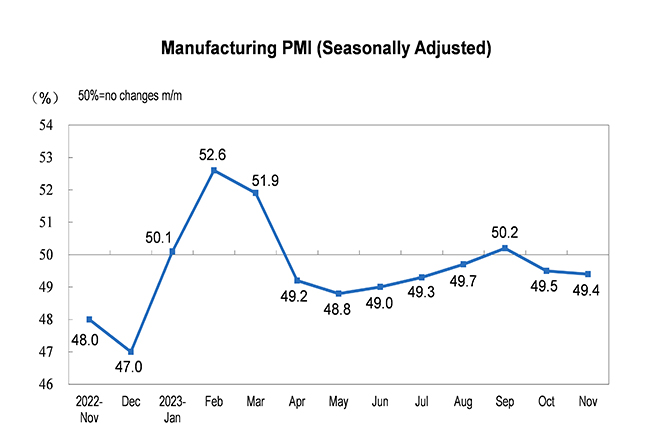
In terms of enterprise size, the PMI for large enterprises was 50.5 percent, a decrease of 0.2 percentage point from the previous month, keeping higher than the threshold; the PMI for medium-sized came in at 48.8 percent, an increase of 0.1 percentage point from the previous month, below the threshold; the PMI for small enterprises stood at 47.8 percent, a decrease of 0.1 percentage point from the previous month, below the threshold.
From the sub-indexes, among the five sub-indexes that constitute the manufacturing PMI, the production index and supplier delivery time index were higher than the threshold, and the new order index, the raw material inventory index and the employment index were lower than the threshold.
The production index was 50.7 percent, a decrease of 0.2 percentage point from the previous month, still higher than the threshold, indicating that manufacturing production activities kept expanding.
The new order index was 49.4 percent, a decrease of 0.1 percentage point from the previous month, indicating that the market demand of the manufacturing industry has slightly scaled down.
The raw material inventory index was 48.0 percent, a decrease of 0.2 percentage point from the previous month, indicating that the inventory of major raw materials in the manufacturing industry declined.
The employment index was 48.1 percent, an increase of 0.1 percentage point from the previous month, indicating a slight growth in the climate level of employment of manufacturing enterprises.
The supplier delivery time index was 50.3 percent, an increase of 0.1 percentage point from the previous month, indicating that the delivery time of raw material suppliers in the manufacturing industry continued to decrease.
China's Manufacturing PMI (Seasonally Adjusted)
|
Unit: % |
||||||
|
PMI |
||||||
|
Production Index |
New Order Index |
Raw Material Inventory Index |
Employment Index |
Supplier Delivery Time Index |
||
|
2022-November |
48.0 |
47.8 |
46.4 |
46.7 |
47.4 |
46.7 |
|
December |
47.0 |
44.6 |
43.9 |
47.1 |
44.8 |
40.1 |
|
2023-January |
50.1 |
49.8 |
50.9 |
49.6 |
47.7 |
47.6 |
|
February |
52.6 |
56.7 |
54.1 |
49.8 |
50.2 |
52.0 |
|
March |
51.9 |
54.6 |
53.6 |
48.3 |
49.7 |
50.8 |
|
April |
49.2 |
50.2 |
48.8 |
47.9 |
48.8 |
50.3 |
|
May |
48.8 |
49.6 |
48.3 |
47.6 |
48.4 |
50.5 |
|
June |
49.0 |
50.3 |
48.6 |
47.4 |
48.2 |
50.4 |
|
July |
49.3 |
50.2 |
49.5 |
48.2 |
48.1 |
50.5 |
|
August |
49.7 |
51.9 |
50.2 |
48.4 |
48.0 |
51.6 |
|
September |
50.2 |
52.7 |
50.5 |
48.5 |
48.1 |
50.8 |
|
October |
49.5 |
50.9 |
49.5 |
48.2 |
48.0 |
50.2 |
|
November |
49.4 |
50.7 |
49.4 |
48.0 |
48.1 |
50.3 |
Related Indicators of China's Manufacturing PMI (Seasonally Adjusted)
|
Unit: % |
||||||||
|
New Export Order Index |
Import Index |
Purchase Quantity Index |
Main Raw Material Purchase Price Index |
Producer Price Index |
Finished Goods Inventory Index |
Existing Order Index |
Production and Operation Expectation Index |
|
|
2022-November |
46.7 |
47.1 |
47.1 |
50.7 |
47.4 |
48.1 |
43.4 |
48.9 |
|
December |
44.2 |
43.7 |
44.9 |
51.6 |
49.0 |
46.6 |
43.1 |
51.9 |
|
2023-January |
46.1 |
46.7 |
50.4 |
52.2 |
48.7 |
47.2 |
44.5 |
55.6 |
|
February |
52.4 |
51.3 |
53.5 |
54.4 |
51.2 |
50.6 |
49.3 |
57.5 |
|
March |
50.4 |
50.9 |
53.5 |
50.9 |
48.6 |
49.5 |
48.9 |
55.5 |
|
April |
47.6 |
48.9 |
49.1 |
46.4 |
44.9 |
49.4 |
46.8 |
54.7 |
|
May |
47.2 |
48.6 |
49.0 |
40.8 |
41.6 |
48.9 |
46.1 |
54.1 |
|
June |
46.4 |
47.0 |
48.9 |
45.0 |
43.9 |
46.1 |
45.2 |
53.4 |
|
July |
46.3 |
46.8 |
49.5 |
52.4 |
48.6 |
46.3 |
45.4 |
55.1 |
|
August |
46.7 |
48.9 |
50.5 |
56.5 |
52.0 |
47.2 |
45.9 |
55.6 |
|
September |
47.8 |
47.6 |
50.7 |
59.4 |
53.5 |
46.7 |
45.3 |
55.5 |
|
October |
46.8 |
47.5 |
49.8 |
52.6 |
47.7 |
48.5 |
44.2 |
55.6 |
|
November |
46.3 |
47.3 |
49.6 |
50.7 |
48.2 |
48.2 |
44.4 |
55.8 |
2. Non-manufacturing Purchasing Managers Index
In November, the non-manufacturing business activity index was 50.2 percent, a decrease of 0.4 percentage point from the previous month, still higher than the threshold, indicating that the non-manufacturing industry maintained expansion.
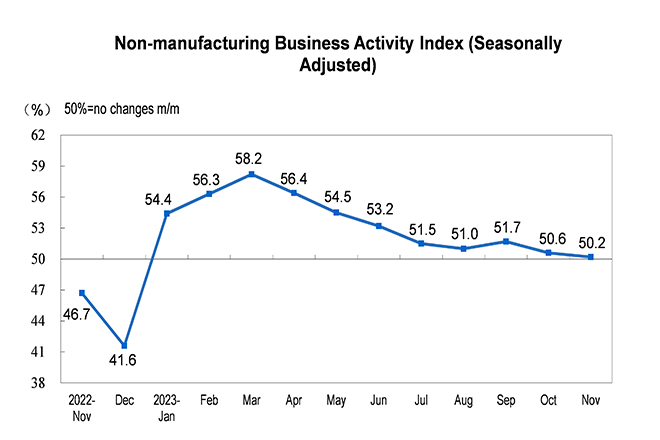
By industry, the business activity index for the construction industry was 55.0 percent, an increase of 1.5 percentage points from the previous month; that for the service industry was 49.3 percent, a decrease of 0.8 percentage point from the previous month. From the perspective of industry, the business activity indexes for waterway transportation, telecommunication, broadcast, television and satellite transmission services and monetary and financial services were within the high expansion range of 55.0 percent and above; and the business activity indexes for real estate and leasing and business services were below the threshold.
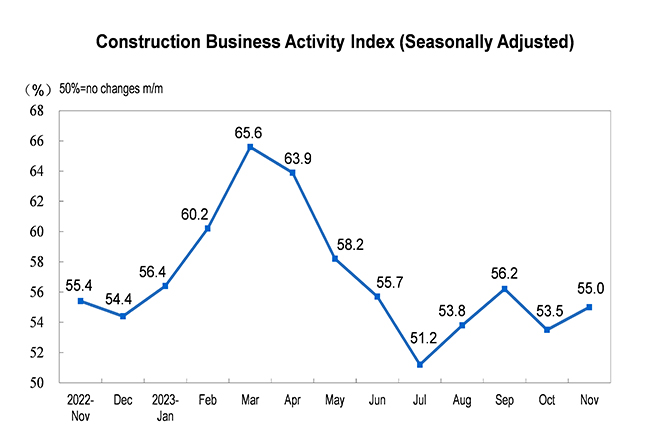
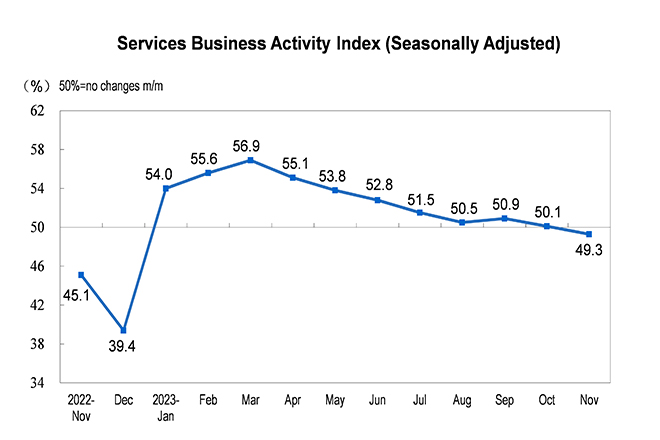
The new order index was 47.2 percent, an increase of 0.5 percentage point from the previous month, still below the threshold, indicating that the contraction range of the non-manufacturing market demand narrowed. By industry, the new order index for the construction industry came in at 48.6 percent, a decrease of 0.6 percentage point from the previous month; that for the service industry stood at 46.9 percent, an increase of 0.7 percentage point from the previous month.
The input price index was 49.8 percent, an increase of 0.1 percentage point from the previous month, still below the threshold, indicating that the overall level of input prices used by non-manufacturing enterprises for business activities remained slightly lower than in the previous month. By industry, the input price index for the construction industry came in at 53.1 percent, an increase of 3.2 percentage points from the previous month; that for the service industry stood at 49.2 percent, a decrease of 0.5 percentage point from the previous month.
The sales price index was 48.3 percent, a decrease of 0.3 percentage point from the previous month, indicating that the overall non-manufacturing sales prices declined. By industry, the sales price index for the construction industry came in at 51.3 percent, an increase of 1.3 percentage points from the previous month; that for the service industry stood at 47.7 percent, a decrease of 0.6 percentage point from the previous month.
The employment index was 46.9 percent, an increase of 0.4 percentage point from the previous month, indicating a slight growth in the climate level of employment of non-manufacturing enterprises. By industry, the employment index for the construction industry came in at 48.2 percent, an increase of 1.8 percentage points from the previous month; that for the service industry stood at 46.7 percent, an increase of 0.2 percentage point from the previous month.
The business activity expectation index was 59.8 percent, an increase of 1.7 percentage points from the previous month, indicating that non-manufacturing enterprises maintained strong confidence about the recent market recovery and development. By industry, the business activity expectation index for the construction industry came in at 62.6 percent, an increase of 1.2 percentage points from the previous month; that for the service industry stood at 59.3 percent, an increase of 1.8 percentage points from the previous month.
Main Indexes of China's Non-manufacturing PMI (Seasonally Adjusted)
|
Unit: % |
||||||
|
Business Activity Index |
New Order Index |
Input Price Index |
Sales Price Index |
Employment Index |
Business Activity Expectation Index |
|
|
2022-November |
46.7 |
42.3 |
49.9 |
48.7 |
45.5 |
54.1 |
|
December |
41.6 |
39.1 |
49.2 |
47.5 |
42.9 |
53.7 |
|
2023-January |
54.4 |
52.5 |
51.5 |
48.3 |
46.7 |
64.9 |
|
February |
56.3 |
55.8 |
51.1 |
50.8 |
50.2 |
64.9 |
|
March |
58.2 |
57.3 |
50.3 |
47.8 |
49.2 |
63.3 |
|
April |
56.4 |
56.0 |
51.1 |
50.3 |
48.3 |
62.5 |
|
May |
54.5 |
49.5 |
47.4 |
47.6 |
48.4 |
60.4 |
|
June |
53.2 |
49.5 |
49.0 |
47.8 |
46.8 |
60.3 |
|
July |
51.5 |
48.1 |
50.8 |
49.7 |
46.6 |
59.0 |
|
August |
51.0 |
47.5 |
51.7 |
50.0 |
46.8 |
58.2 |
|
September |
51.7 |
47.8 |
52.5 |
50.3 |
46.8 |
58.7 |
|
October |
50.6 |
46.7 |
49.7 |
48.6 |
46.5 |
58.1 |
|
November |
50.2 |
47.2 |
49.8 |
48.3 |
46.9 |
59.8 |
Other Indexes of China's Non-manufacturing PMI (Seasonally Adjusted)
|
Unit: % |
||||
|
New Export Order Index |
Existing Order Index |
Inventory Index |
Supplier Delivery Time Index |
|
|
2022-November |
46.1 |
43.2 |
45.6 |
45.0 |
|
December |
44.5 |
43.0 |
45.4 |
40.4 |
|
2023-January |
45.9 |
43.3 |
47.7 |
49.7 |
|
February |
51.9 |
50.3 |
48.2 |
55.2 |
|
March |
48.1 |
45.6 |
47.0 |
52.4 |
|
April |
52.1 |
45.5 |
47.2 |
52.4 |
|
May |
49.7 |
43.9 |
47.1 |
51.9 |
|
June |
49.0 |
43.9 |
47.1 |
51.9 |
|
July |
47.7 |
43.8 |
45.9 |
51.4 |
|
August |
47.9 |
43.7 |
46.2 |
52.0 |
|
September |
49.4 |
43.3 |
46.9 |
51.3 |
|
October |
49.1 |
43.1 |
46.2 |
52.0 |
|
November |
46.8 |
43.0 |
46.7 |
51.8 |
3. Composite PMI Output Index
In November, the composite PMI output index was 50.4 percent, a decrease of 0.3 percentage point from the previous month, indicating that the overall production and operation of Chinese enterprises maintained expansion.
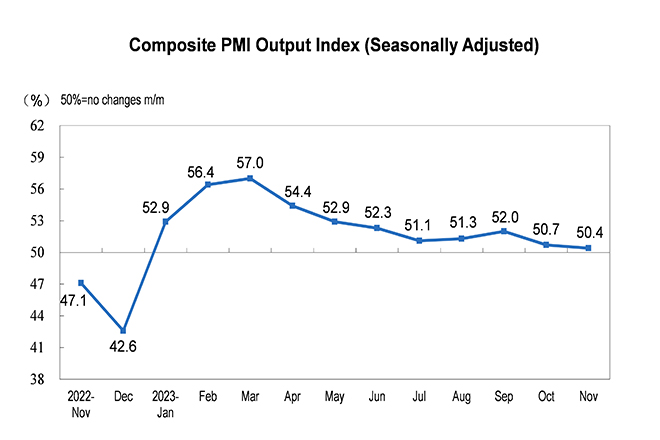
Annotations:
1. Explanatory Notes
Purchasing Managers Index (PMI) is an index summarized and compiled through the results of the monthly survey of enterprises' purchasing managers. It covers every link of the enterprises, including purchasing, production, logistics, and so on. It is one of the leading indexes commonly adopted by international society to monitor the macroeconomic trends and plays an important role in forecasting and monitoring. The Composite PMI Output Index, belonging to the PMI system, is a composite index reflecting the changes in the output in current period of the entire industry (manufacturing and non-manufacturing industries). If the PMI is above 50 percent, it reflects the overall economy is expanding over the last month; if below 50 percent, it reflects the overall economy is in contraction over the last month.
2. Statistical Coverage
The survey involves 3200 samples from 31 divisions of the manufacturing industry in the “Industrial Classification for National Economic Activities” (GB/T4754-2017), as well as 4300 samples from 43 divisions of the non-manufacturing industry.
3. Survey Methods
PPS (Probability Proportional to Size) sampling method was adopted in the purchasing managers’ survey. Using the divisions of the manufacturing or non-manufacturing industry as the selecting strata, the sample size of each division is proportional to its proportion of the value-added of the division to the total value-added of the manufacturing or non-manufacturing industry. Within the stratum, the samples are selected according to the probabilities proportional to their principal business revenues of the enterprises.
The survey was organized and conducted by staff members of survey offices directly subordinated to the NBS, monthly through the Online Reporting System of NBS by sending survey questionnaires to the purchasing managers of the selected enterprises.
4. Calculation Methods
(1) Calculation Methods of Sub-indexes. The index system of the manufacturing purchasing managers’ survey covers 13 sub-indexes such as production, new orders, new export orders, existing orders, finished goods inventory, purchase, import, purchasing price, producer price, raw materials inventory, employment, supplier delivery time, and production and operation expectation. The index system of non-manufacturing purchasing managers’ survey covers 10 sub-indexes such as business activities, new orders, new export orders, existing orders, finished goods inventory, input price, sales price, employment, supplier delivery time, and business activity expectation. Sub-indexes adopt the diffusion index calculation method, i.e. percentage of positive answers in a number of enterprises plus half of the percentage in the same answers. Due to the lack of non-manufacturing composite PMI index, the international society often used business activity index to reflect the overall changes in non-manufacturing economic development.
(2) Calculation Methods of Manufacturing PMI. Manufacturing PMI was calculated according to five diffusion indexes (group indexes) and their weights. 5 group indexes and their weights are determined in accordance with their leading impact on the economy. Specifically, new order index weighted 30 percent; production index weighted 25 percent; employment index weighted 20 percent; supplier delivery time index weighted 15 percent; raw materials inventory index weighted 10 percent. Among them, the supplier delivery time index is a converse index, and contrary calculation is needed when combines it into PMI.
(3) Calculation Methods of Composite PMI Output Index. Composite PMI Output Index was calculated by weighted summation of the manufacturing output index and non-manufacturing business activity index. Their weights are determined by the proportion of manufacturing and non-manufacturing industries in GDP.
5. Seasonal adjustment
The purchasing managers’ survey is a monthly survey, the data of the survey fluctuates very much for the influences of seasonal factors. The released readings are seasonally adjusted data.
